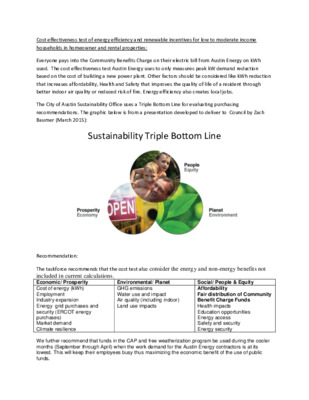Item 4a-Triple Bottom Line Cost Test for EE Renewable Energy_Tim Arndt — original pdf
Backup

Cost effectiveness test of energy efficiency and renewable incentives for low to moderate income households in homeowner and rental properties: Everyone pays into the Community Benefits Charge on their electric bill from Austin Energy on kWh used. The cost effectiveness test Austin Energy uses to only measures peak kW demand reduction based on the cost of building a new power plant. Other factors should be considered like kWh reduction that increases affordability, Health and Safety that improves the quality of life of a resident through better indoor air quality or reduced risk of fire. Energy efficiency also creates local jobs. The City of Austin Sustainability Office uses a Triple Bottom Line for evaluating purchasing recommendations. The graphic below is from a presentation developed to deliver to Council by Zach Baumer (March 2015): Sustainability Triple Bottom Line Recommendation: The taskforce recommends that the cost test also consider the energy and non-energy benefits not included in current calculations. Economic/ Prosperity Environmental/ Planet Social/ People & Equity Cost of energy (kWh) Employment Industry expansion Energy grid purchases and security (ERCOT energy purchases) Market demand Climate resilience GHG emissions Water use and impact Air quality (including indoor) Land use impacts Affordability Fair distribution of Community Benefit Charge Funds Health impacts Education opportunities Energy access Safety and security Energy security We further recommend that funds in the CAP and free weatherization program be used during the cooler months (September through April) when the work demand for the Austin Energy contractors is at its lowest. This will keep their employees busy thus maximizing the economic benefit of the use of public funds.